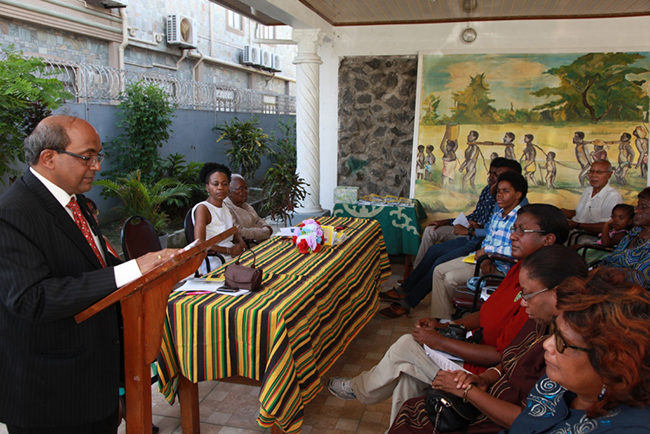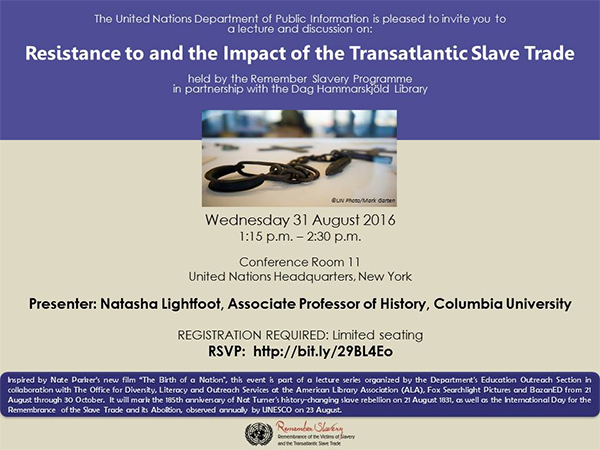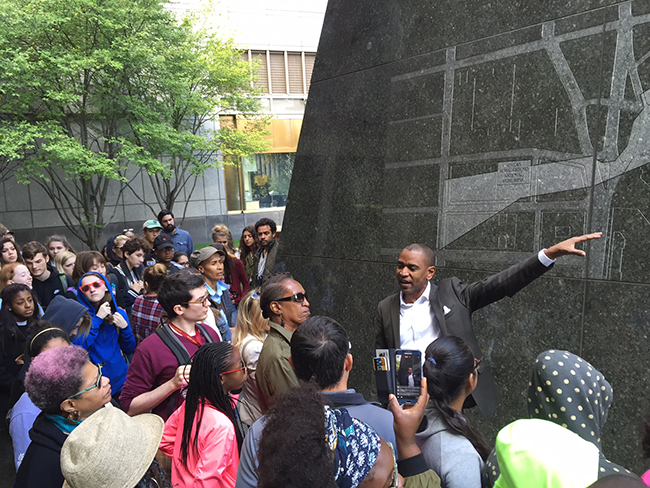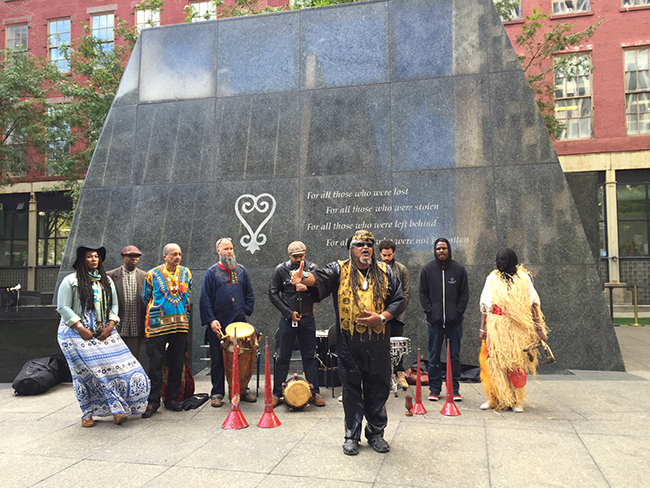
2016 Remembrance Programme
" Remember Slavery: Celebrating the Heritage and Culture of the African Diaspora and its Roots"
This theme draws attention to the rich African culture and traditions that have impacted life in countries that were involved in the slave trade and where the African Diaspora continues to make major contribution in all aspects of life. It also highlights the cultural linkages that exist among people of African descent throughout the world.
Message of the United Nations Secretary-General | Calendar of Events | Special Commemorative Meetings and Events | Promotional materials for the 2016 commemoration
Message of the United Nations Secretary-General
Each year on this day, the United Nations honours the memory of millions of Africans forcibly removed from their families and homelands over hundreds of years.
The International Day of Remembrance of the Victims of Slavery and the Transatlantic Slave Trade also shines a spotlight on prevailing racism and prejudice today.
It is imperative that we work together for equal opportunity, justice and sustainable development for people of African descent. That is why the United Nations Remember Slavery Programme is reaching out to young and old alike to create awareness, promote understanding and change attitudes.
The theme of this year’s observance is “Remember Slavery: Celebrating the Heritage and Culture of the African Diaspora and its Roots”.
The dynamic culture and traditions of Africa continue to enrich life in the countries that were once involved in the Transatlantic slave trade.
Africa’s influence and legacy are plain to see in the vibrant music, bold art, rich foods and inspiring literature that infuse modern culture. Less recognized, perhaps, are the contributions that the people of the African diaspora have made to medicine, science, government and general leadership in society.
Tested to the limits of their spirit and endurance, slaves from Africa left their descendants a wide range of invaluable assets, including fortitude, courage, strength, tolerance, patience and compassion. On this Day, let us renew our resolve to fight racism and celebrate the heritage of Africa that enhances societies around the world today.
Ban Ki-moon
Calendar of Events
Download the Programme of Events
Tuesday, 16 February
Private Screening of RACE
AMC Loews 34th Street, New York
Directed by Stephen Hopkins, RACE is a film about courage, determination, tolerance, and friendship. It is an inspiring drama about Jesse Owen's fight to become a legend at the 1936 Olympics, where he faces off against Adolf Hitler and the Nazi party’s vision of white supremacy. A Q & A follows film.
Wednesday, 17 February
6:00 p.m. Exhibit Opening - Africans in India: From Slaves to Generals and Rulers
Visitors Lobby, United Nations, New York
The exhibition, which was on display at United Nations Headquarters in New York through 30 March 2016, was created by The Schomburg Center for Research in Black Culture of The New York Public Library. The curators are Dr. Sylviane A. Diouf, Director of the Lapidus Center for the Historical Analysis of Transatlantic Slavery at The Schomburg Center, and Dr. Kenneth X. Robbins, collector and expert in Indian art.
The exhibit tells the fascinating history of enslaved East Africans in India, known as Sidis and Habshis, who rose to positions of military and political authority. Through colourful photographs and texts, the exhibit conveys that their success was also a testimony of the open-mindedness of Indian society in which they were a small religious and ethnic minority, originally of low status. It also sheds light on the slave trade in the Indian Ocean and the history of Africa and its Diaspora in India.
The Remember Slavery Programme is producing a travelling version of the exhibition in Arabic, English, French, Portuguese and Spanish and displayed by the United Nations Information Centres around the world in observance of the International Day of Remembrance of the Victims of Slavery and the Transatlantic Slave Trade.
Thursday 24 March
1:15 p.m. - 2:45 p.m. - Panel Discussion and Performance: “The Transatlantic Slave Trade: Constructing New Amistad, Bunce Island, Gullah, Maroon and Nova Scotia Bridges” ECOSOC Chamber, United Nations, New York
Link to the invitation
Tuesday, 29 March
International Day of Remembrance of the Victims of Slavery and the Transatlantic Slave Trade (Observed)
3:00 p.m. General Assembly Commemorative Meeting, GA Hall, United Nations, New York
6:30 p.m. Culinary & Cultural Experience, Visitors Lobby, United Nations, New York (Link to the invitation)
Statements:
- Remarks by H.E Mr Mogens Lykketoft, President of the 70th session of the UN General Assembly (see the video of the remarks)
- Statement of H.E. Jan Eliasson, Deputy Secretary-General of the United Nations (see the video of the statement)
Thursday, 31 March
25th Anniversary of African Burial Ground
9:30 a.m. Student Event (4th grade): Film Screening /Art /Tour
6:15 p.m. Screening of documentary and panel discussion – “Then I'll Be Free to Travel Home: The Legacy of the New York African Burial Ground” featuring Lena Horne, African Burial Ground, 290 Broadway, New York
Thursday, 14 April
NGO Briefing: The Musical Journey of the African Diaspora
11:00 a.m. - Conference Room 11, United Nations, New York
Special Commemorative Meetings and Events
Leonardo DiCaprio visits UN’s slavery memorial

Actor and producer Leonardo DiCaprio, a United Nations Messenger of Peace, visited The Ark of Return, the Permanent Memorial to Honour the Victims of Slavery and the Transatlantic Slave Trade, at United Nations Headquarters in New York on 22 April 2016, as he exited the official signing ceremony for the Paris Agreement on climate change. During his speech at that ceremony, Mr. DiCaprio compared climate change to slavery, declaring that both were defining crises of their times.
2016 Global Student Video Conference
The 8th Annual United Nations 'Remember Slavery' Global Student Video Conference was held at United Nations Headquarters in New York on 13 May 2016 from 9:30 a.m. to 12:00 p.m. The theme was "Celebrating the Heritage and Culture of the African Diaspora and its Roots".
Students had the opportunity to learn about the rich African culture and traditions that have impacted life in countries that were involved in the slave trade and where the African Diaspora continues to make major contributions to all aspects of life. The event promoted a greater knowledge of and respect for the diverse heritage, culture and contribution of people of African descent to the development of societies.
There was an expert presentation on African heritage and culture by Dr. Sheila S. Walker, Executive Director of Afrodiaspora, Inc., as well as an artistic performance by students. Participants learned about the Ark of Return, the Permanent Memorial at United Nations Headquarters to Honour the Victims of Slavery and the Transatlantic Slave Trade, from the architect who designed it, Rodney Leon. H.E. Ms. A. Missouri Sherman-Peter, Permanent Observer of the Caribbean Community (CARICOM) to the United Nations, led the students in an activity. With the support of the UNESCO Associated Schools Project Network (ASPnet), the event included students from Dakar, Senegal, and Port-of-Spain, Trinidad and Tobago, who participated via video link. Teachers received a study guide that helped prepare students for the event.
The Global Student Video Conference can be watched on UN WebTV.
“Africans in India” exhibit travels to Guyana
The traveling exhibit “Africans in India: From Slaves to Generals and Rulers” was displayed at the Museum for African Heritage in Georgetown, Guyana, as part of the country’s yearlong Golden Jubilee independence celebrations. The opening ceremony was held on 6 August 2016, with the support of the United Nations Department of Public Information’s Remember Slavery Programme and the New York Public Library’s Schomburg Center for Research in Black Culture. The ceremony also commemorated the abolition of slavery in the colony of British Guiana on 1 August 1834 and was held in conjunction with the Museum’s observance of the United Nations International Decade for People of African Descent (2015-2024).
This exhibit was of particular interest in Guyana, where the great majority of people are either descendants of enslaved Africans, indentured laborers from India or a mix of the two. In a keynote address, H.E. Mr. V. Mahalingam, High Commissioner of India to Guyana, underscored the important historical ties between the peoples of the Indian subcontinent and Africa. He mentioned the presence in India of Sidhis, a people who are believed to have arrived in India from Africa between the fourth and seventeenth centuries. He also noted the robust diplomatic, cultural and economic ties between India and Africa, made evident by the Third India-Africa Forum Summit in New Delhi in October 2015, which had been attended by 41 African Heads of State.
The exhibit opening also included the presentation of documentaries on the Sidhis that were produced by Mary Jagdeo-Ferreira, a Guyanese national working at the United Nations Department of Public Information.
The exhibition was curated by Sylviane A. Diouf, Director of the Lapidus Center for the Historical Analysis of Transatlantic Slavery at the Schomburg Center, and Kenneth X. Robbins, acollector and expert in Indian art. The traveling exhibit was produced in partnership with the United Nations Remember Slavery Programme.

Indian High Commissioner to Guyana V. Mahalingam addresses opening ceremony of "Africans in India" exhibit in Guyana
Lecture on resistance to and impact of Transatlantic Slave Trade
The Education Outreach Section of the United Nations Department of Public Information’s Outreach Division – in partnership with the United Nations Dag Hammarskjöld Library – hosted a lecture as part of its Remember Slavery Programme on 31 August 2016 from 1:15 p.m. to 2:30 p.m. at United Nations Headquarters in Conference Room 11 in New York. Titled “Resistance to and the Impact of the Transatlantic Slave Trade”, the event was held under the umbrella of “The Birth of a Nation: Slavery, Resistance & Abolition” lecture series.
The United Nations Remember Slavery Programme joined the Office for Diversity, Literacy and Outreach Services at the American Library Association (ALA); Fox Searchlight Pictures; and BazanED in this nationwide knowledge- and community-building initiative.
Natasha Lightfoot, Associate Professor of History at Columbia University, delivered the lecture and led a discussion on the historic struggle against slavery and the lasting legacy of the Transatlantic Slave Trade. Opening remarks were delivered by Maher Nasser, Director of the Outreach Division of the United Nations Department of Public Information. There was also a statement by Marie Paule Roudil, Director of the Liaison Office of the United Nations Educational, Scientific and Cultural Organization (UNESCO) in New York.
The lecture series, inspired by Nate Parker’s film “The Birth of a Nation”, ran throughout the United States from 21 August through 30 October, commemorating the duration of the history-changing slave rebellion launched by the film’s subject, Nat Turner, on 21 August 1831. It marked the 185th anniversary of Turner’s rebellion, as well as the International Day for the Remembrance of the Slave Trade and its Abolition, observed annually by UNESCO on 23 August.
The lecture can also be watched on UN WebTV.

UN ‘Remember Slavery’ team visits African Burial Ground
On 5 October 2016, staff from the United Nations Remember Slavery Programme visited the African Burial Ground National Monument in New York for the site’s 25th anniversary commemoration.

Rodney Leon, an American architect of Haitian descent, who designed the monument, told attendees that both free and enslaved Africans had been buried at the site until 1794. He added that he had also designed “The Ark of Return”, the Permanent Memorial to Honour the Victims of Slavery and the Transatlantic Slave Trade at United Nations Headquarters in New York.

Following the event, the United Nations team distributed information about the Remember Slavery Programme and invited participants to visit “The Ark of Return”.
Suriname’s Ambassador to the UN visits “The Ark of Return”
The Permanent Representative of Suriname to the United Nations, H.E. Mr. Henry Mac Donald, visited “The Ark of Return”, the Permanent Memorial to Honour the Victims of Slavery and the Transatlantic Slave Trade at United Nations Headquarters in New York, on 7 December 2016. He was accompanied by a delegation including Surinamese writer Cynthia McLeod and members of the Netherlands-based Mapping Slavery Project. The visitors learned the story behind the monument, which was designed by architect Rodney Leon and serves as a tool to raise awareness about the terrible history and ongoing legacy of the transatlantic slave trade. Reflecting on the monument’s significance, Ambassador Mac Donald said, "This memorial is important because we need to make sure that the entire history of slavery and the transatlantic slave trade doesn’t repeat itself."
Weekly briefings at the Memorial are held every Wednesday from 10:30 to 11:00 a.m.
The Permanent Representative of Suriname to the United Nations, H.E. Mr. Henry Mac Donald (centre), discusses “The Ark of Return” with Surinamese writer Cynthia McLeod (right)
Promotional materials for the 2016 commemoration
 Arabic |
 Chinese |
 English |
 French |
 Russian |
 Spanish |
 Kiswahili |
Press Release: UN General Assembly commemorates abolition of slavery and transatlantic slave trade

